生命周期评价
第2章 生命周期评价发展及概念

第2章生命周期评价发展及概念2.1生命周期评价的起源和发展生命周期评价是一种评价产品整个生命周期(即从摇篮到坟墓)的环境影响和资源消耗的方法。
生命周期评价最初是在物质和能量流分析的基础上发展而来的。
世界上的第一个生命周期评价的案例是1969年美国中西部研究所(MRI)对可口可乐的饮料瓶进行的从最初的原材料采掘到最终的废弃物处理的全过程跟踪和定量分析,这是公认的生命周期评价研究开始的标志,也给目前的生命周期清单分析方法确定了基础。
20世纪70年代早期,美国和欧洲的其他一些公司也完成了类似的生命周期清单分析。
这种把产品资源利用和环境排放量化的过程逐渐被认为是“资源和环境纲要分析(Resource and Environmental Profile Analysis,REPA)”,在美国已经得到实践证实。
这种过程在欧洲被称为生态平衡(Ecobalance)。
20世纪70年代到80年代,生命周期评价还仅在很小的范围内展开,而且评价考虑的因素很少。
到了20世纪80年代以后,欧美从事工艺研究和环境评价的一些大学和顾问公司发展了生命周期评价这一方法,把“物质能量流平衡方法”引入到工业产品整个寿命周期的分析中,以考察工艺过程的各个环节,即原料的开掘、制造、运输与分发、使用、循环使用,直至废弃的整个过程对环境的综合影响,并逐渐在企业中得到了应用,但由于方法的不规范,以致评价的结果很难达成一致,所以并没有广泛地展开。
20世纪90年代以后,国际环境毒理学和化学学会组织(SETAC)在有关生命周期评价的国际研讨会上首次提出了“生命周期评价(Life Cycle Assessment,LCA)”的概念。
经过20多年的实践,在国际环境毒理学和化学学会组织和国际标准组织(ISO)的共同努力下,生命周期评价方法论的国际标准化取得了重要进展,于1997至2000年相继推出了ISO 14040-ISO 14043等相关标准。
2.2生命周期评价的概念目前,生命周期评价的定义有很多种提法,政府、企业和一些机构站在各自的立场对它都有一番描述,如:(1)美国环保局的定义:对自最初从地球中获得原材料开始,到最终所有的残留物质返归地球结束的任何一种产品或人类活动所带来的污染物排放及其环境影响进行估测的方法;(2)国际环境毒理学和化学学会(SETAC)的定义:是一个评价与产品、工艺或行动相关的环境负荷的客观过程,它通过识别和量化能源与材料使用和环境排放,评价这些能源与材料使用和环境排放的影响,并评估和实施影响环境改善的机会。
我国生命周期评价文献综述及国外研究进展

我国生命周期评价文献综述及国外研究进展一、概述生命周期评价(Life Cycle Assessment,LCA)是一种评价产品或服务在其整个生命周期内环境影响的系统性方法。
该方法自20世纪60年代末期诞生以来,已在全球范围内得到了广泛的关注和应用。
在我国,随着环境问题的日益严重和可持续发展的呼声不断提高,生命周期评价也逐渐成为环境管理、生态经济和政策制定等领域的重要工具。
我国生命周期评价的研究和实践起步于20世纪90年代,经过几十年的发展,已经取得了一定的成果。
众多学者和专家在生命周期评价的理论研究、方法创新、案例应用等方面进行了深入的探索和实践,为我国的环境保护事业和可持续发展做出了积极贡献。
与此同时,国外在生命周期评价领域的研究也取得了显著的进展。
国外学者在生命周期评价的理论框架、评价方法、数据库建设、案例研究等方面进行了大量深入的工作,推动了生命周期评价在全球范围内的普及和应用。
这些研究成果和经验对我国生命周期评价的发展具有重要的借鉴意义。
本文旨在综述我国生命周期评价的研究现状,分析存在的问题和挑战,并介绍国外在该领域的研究进展。
通过对国内外研究成果的比较和借鉴,以期为我国生命周期评价的进一步发展和完善提供参考和启示。
1.1 研究背景随着全球环境问题日益凸显,各国对可持续发展的重视程度不断提升。
生命周期评价(Life Cycle Assessment,LCA)作为一种系统性的环境管理工具,在评估产品、服务或系统在整个生命周期内对环境的潜在影响方面发挥着关键作用。
自20世纪60年代末美国首次提出LCA概念以来,该方法在全球范围内得到了广泛应用与发展。
特别是在我国,随着经济的快速增长和资源环境压力的加大,LCA已经成为制定环境政策、指导绿色生产和消费、推动循环经济发展的重要依据。
尽管LCA在我国得到了越来越多的关注和应用,但相关研究仍面临诸多挑战。
一方面,我国生命周期评价的理论体系和实践经验尚不成熟,与国际先进水平存在一定差距另一方面,国内外在LCA方法学、数据基础、评价指标体系等方面也在不断更新和完善,需要我国研究者及时跟踪并掌握最新进展。
简述生命周期评价的定义
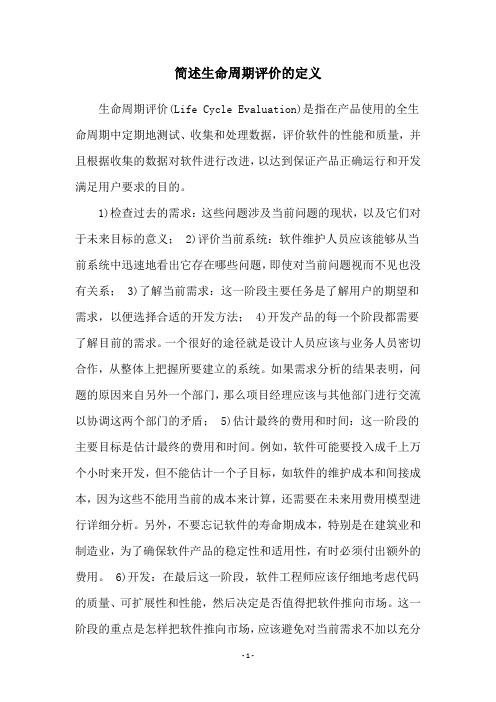
简述生命周期评价的定义生命周期评价(Life Cycle Evaluation)是指在产品使用的全生命周期中定期地测试、收集和处理数据,评价软件的性能和质量,并且根据收集的数据对软件进行改进,以达到保证产品正确运行和开发满足用户要求的目的。
1)检查过去的需求:这些问题涉及当前问题的现状,以及它们对于未来目标的意义; 2)评价当前系统:软件维护人员应该能够从当前系统中迅速地看出它存在哪些问题,即使对当前问题视而不见也没有关系; 3)了解当前需求:这一阶段主要任务是了解用户的期望和需求,以便选择合适的开发方法; 4)开发产品的每一个阶段都需要了解目前的需求。
一个很好的途径就是设计人员应该与业务人员密切合作,从整体上把握所要建立的系统。
如果需求分析的结果表明,问题的原因来自另外一个部门,那么项目经理应该与其他部门进行交流以协调这两个部门的矛盾; 5)估计最终的费用和时间:这一阶段的主要目标是估计最终的费用和时间。
例如,软件可能要投入成千上万个小时来开发,但不能估计一个子目标,如软件的维护成本和间接成本,因为这些不能用当前的成本来计算,还需要在未来用费用模型进行详细分析。
另外,不要忘记软件的寿命期成本,特别是在建筑业和制造业,为了确保软件产品的稳定性和适用性,有时必须付出额外的费用。
6)开发:在最后这一阶段,软件工程师应该仔细地考虑代码的质量、可扩展性和性能,然后决定是否值得把软件推向市场。
这一阶段的重点是怎样把软件推向市场,应该避免对当前需求不加以充分考虑就开始写程序。
7)维护:这是软件生命周期的最后一个阶段,包括持续的支持服务,如软件的复用和版本控制等。
在进行管理维护之前,必须先进行风险分析,如果认为软件无法维护,则应立即放弃,以免导致巨大的损失。
生命周期评价既要定性,又要定量,由于它涉及一个企业内部多个部门的协调,评价人员会感到困难,实施也很不容易。
所以,在实践中,生命周期评价往往被看作是一种公司级的项目评价。
《生命周期评价》课件

对企业和个人的建议
01
企业应积极采用生命周期评价方法,全面评估产品或服务的环境影响 ,为可持续发展作出贡献。
02
个人应关注自身消费行为对环境的影响,通过合理消费减少不必要的 环境负担。
03
企业和个人应积极参与环保活动和公益事业,提高环保意识,推动全 社会共同关注和参与环境保护。
04
企业应加强与科研机构、政府部门的合作与交流,共同研发和应用更 高效的环境保护技术和方法。
在此添加您的文本16字
考虑产品A废弃后的处理方式,包括回收、再利用和最终 处置的环境影响。
在此添加您的文本16字
综合评估产品A生命周期的环境、经济和社会影响,提出 优化建议。
企业B的环境影响评价
总结词:对企业B在生产过程中产生 的环境影响进行全面评估,提出降低
环境影响的措施。
详细描述
分析企业B在生产过程中产生的污染 物排放、能源消耗和资源利用情况。
考虑政策C实施过程中的风险和不确定性,以及应对措 施。
详细描述
评估政策C实施后可能带来的环境、经济和社会效益, 如污染物减排、能源节约和生态恢复等。
综合评估政策C的成本效益,为政策制定提供科学依据 和建议。
05
结论
生命周期评价的未来发展
标准化和规范化
随着全球环境问题日益严重,生命周 期评价将更加标准化和规范化,以提 供更准确和可靠的环境影响评估结果 。
优化与改善
基于影响评估结果,提出优化和改善建议, 降低产品或服务的环境影响。
02
生命周期评价方法
输入分析
01
资源输入
分析产品或服务在生命周期各阶 段所需的各种资源投入,如原材 料、能源等。
过程输入
02
生命周期评价理论

生命周期评价理论生命周期评价理论生命周期评价的概念生命周期评价LCA(Life Cycle Assessment)是一种评价产品、工艺或活动从原材料采集,到产品生产、运输、销售、使用、回用、维护和最终处置整个生命周期阶段有关的环境负荷的过程。
它首先辨识和量化整个生命周期阶段中能量和物质的消耗以及环境释放,然后评价这些消耗和释放对环境的影响,最后辨识和评价减少这些影晌的机会。
从生命周期评价的发展历程来看,有许多对它的定义,其中国际标准化组织IISO)和国际环境毒理学和化学学会(SETAC)的定义最具有权威性。
ISO对生命周期评价的定义是:汇总和评估一个产品或服务体系在其整个寿命周期间的所有投入及产出对环境造成的潜在的影响的方法。
1990年环境毒理学与化学学会ISETAC)生命周期评价定义为:生命周期评价是一种对产品、生产工艺以及活动对环境的压力进行评价的客观过程,它是通过对能量和物质利用、以及废物排放对环境的影响,寻求改善环境影响的机会以及如何利用这种机会。
这种评价贯穿于产品、工艺和活动的整个生命周期,包括原材料提取与加工;产品制造、运输以及销售;产品的使用、再利用和维护;废物循环和最终废物弃置。
生命周期评价的起源与发展生命周期评价最早出现在60 年代末70 年代初的美国。
作为生命周期评价开始的标志是1969年美国中西部研究所对可口可乐公司的饮料包装瓶进行的评价研究,该研究从原材料采掘到废弃物最终处置,进行了全过程的跟踪与定量研究,揭开了生命周期评价的序幕。
当时把这一分析方法称为资源与环境状况分析(Resource and Environmental Profile Analysis,简称REPA)。
从1970年至1974年,整个REPA 研究的焦点是包装品废弃物问题。
20世纪70年代中期由于能源危机,REPA有关能源分析的工作倍受关注。
进入20世纪80年代后,公众的环境意识进一步提高,产品的环境性能成为市场竞争的重要因素。
生命周期评价
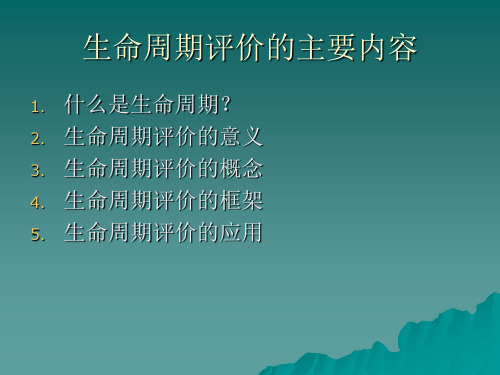
每吨乙醇的净能量Y Y=吨乙醇所含能量-生产一吨乙醇所消耗能量
投入期
成长期
成熟期
衰退期
(二)成长期
新产品试销取得成功以后,转入成批量生产和 扩大市场销售阶段。
1.销售量迅速增长。 金额
销售额曲线
2.产品成本显著下降。
3.销售成本大幅度下降。 利润曲线
4.利润迅速上升。
5.市场开始出现竞争者。
投入期
成长期
成熟期
时间
衰退期
(三)成熟期
指产品进入大批量生产,而在市场上处于竞争最 激烈的阶段。
1.销售量达到最高点。
2. 利润也达到最高点。 金额
销售额曲线
3.市场竞争十分激烈。
利润曲线
4.销售增长率趋进于
零,甚至会出现负数。
时间
投入期
成长期
成熟期
衰退期
(四)衰退期
指产品已逐渐老化,转入产品更新换代的新时期
1、已有新产品开始进入 金额
销售额曲线
市场,正在逐渐代替
老产品。
利润曲线
2、市场销售量日益下降。
② 选择环境影响类型参数和特征化模型:对 选定的环境影响类型,要量化其对环境的影 响大小,就需要了解其作用机理,然后建立 负荷和环境影响之间的关系模型,即特征化 模型。
4) LCA解释
生命周期解释是对生命周期清单分析和/或影响评价 结果进行辨识、量化、核实和评价。提出产品 设计或改进建议等。
五、产品生命周期评价的应用
三、生命周期评价概念
国际环境毒理学和化学学会(SETAC) 定义:是一种客观评价 产品、过程或者活动的环境负荷的方法,该方法通过识别 与量化所有物质和能量的使用以及环境排放,来评价由此 造成的环境影响,评估和实施相应的改善环境表现的机会。
生命周期评价实施的步骤

生命周期评价实施的步骤引言生命周期评价是一种全面评估产品或服务从生产、使用到废弃的环境影响的方法。
通过对生命周期的各个环节进行评估,可以帮助企业识别和优化环境成本,提高资源利用效率,减少环境污染和资源浪费。
本文将介绍生命周期评价实施的一般步骤,以帮助企业进行生命周期评价并获得全面的环境影响信息。
步骤一:确定评价目标和边界首先,需要明确生命周期评价的目标和评价范围。
评价目标可以是减少碳排放、降低水资源消耗、减少废物产生等,评价范围包括产品的生产、运输、使用和废弃等环节。
步骤二:收集数据在进行生命周期评价之前,需要收集大量的数据来支持评价分析。
数据可以包括产品的材料成分、能源消耗、废物排放等信息。
企业可以通过内部数据收集、供应商合作、文献研究等多种方式来获取所需数据。
步骤三:建立评价模型评价模型是进行生命周期评价的基础,它可以将收集到的数据进行整合和分析。
评价模型可以采用各种工具和方法,例如生命周期成本分析、生命周期环境影响评估、生命周期能耗评估等。
通过建立评价模型,可以对产品或服务的环境影响进行量化和比较。
步骤四:数据分析和解释在建立评价模型之后,需要对收集到的数据进行分析和解释。
通过分析数据,可以获得产品或服务在不同生命周期阶段的环境影响情况,识别主要的环境热点和关键影响因素。
步骤五:制定改进建议基于对数据的分析和解释,可以制定改进建议以减少产品或服务的环境影响。
改进建议可以包括使用更环保的材料、采用节能技术、改进生产工艺等。
制定改进建议时,需要综合考虑环境、经济和社会等方面的因素。
步骤六:实施改进建议在制定改进建议之后,需要将其付诸实施。
实施改进建议可能需要多个部门的参与和合作,例如采购部门、生产部门、研发部门等。
通过实施改进建议,可以逐步降低产品或服务的环境影响。
步骤七:监测和评估实施改进建议后,需要进行监测和评估,以确定改进建议的效果和可持续性。
监测和评估可以基于先前建立的评价模型,通过收集和分析数据来评估改进建议的实施效果。
生命周期评价
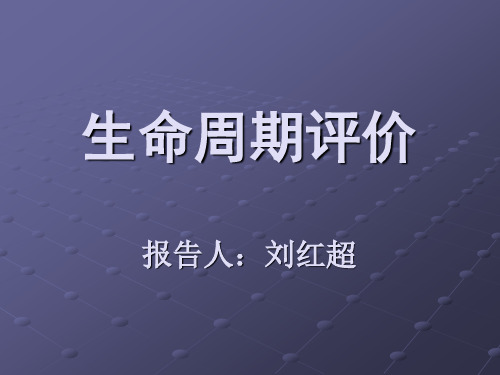
报告人:刘红超
生命周期评价的概念 生命周期评价的各个阶段 生命周期评价发展历程 生命周期评价的应用 生命周期可持续性评价
天津大学管理与经济学部
生命周期评价的概念
生命周期评价(LCA)是一种评价产品、工艺或活动从原材料采 集,到产品生产、运输、销售、使用、回收、维护和最终处置整个生 命周期阶段有关的环境负荷的过程;它首先辨识和量化整个生命周期 阶段中能量和物质的消耗以及环境释放, 然后评价这些消耗和释放对环 境的影响, 最后辨识和评价减少这些影响的机会。生命周期评价注重研 究系统在生态健康、人类健康、资源消耗领域内的环境影响。
制造、加工
输出
能量输入 物质输入
分配、运输
使用、维护
其他释放物
产品和副产品 “三废”排 放
回收、循环
废弃物管理
系统边界
图3 产品的生命周期
天津大学管理与经济学部
生命周期清单分析
清单分析是对产品、工艺或活动在其整个生命周期阶段的资源、能源 消耗和向环境的排放(包括废气、废水、固体废物及其它环境释放物) 进行数据量化分析。
生命周期评价在工业生产中的应用
天津大学管理与经济学部
生命周期可持续性评价
未来生命周期评价的发展趋势
2009年公布的CALCAS计划指出,未来的十年将是生命周期可持续分析的 十年。同时为生命周期可持续评价(LCSA)提出了一个新的框架,这个框架 将原来ISO框架中清单分析和影响评价部分合成为一个中间建模阶段。它拓 宽了生命周期评价的范围,囊括了环境、经济和社会3个维度的可持续信息。 LCSA不是一个只包含自身的一个框架模型,它是一个跨学科的框架的整合, 集成了各个学科的模型和方法,将这些方法进行选择并且进行结合,以解决 和回答具体的生命周期可持续性问题。 Matthias Finkbeiner(2010)将马斯洛关于人类需求层次的金字塔进行 改善,提出了生命周期可持续评价(LCSA)发展历程的金字塔,直观的展示
第三章_生命周期评价
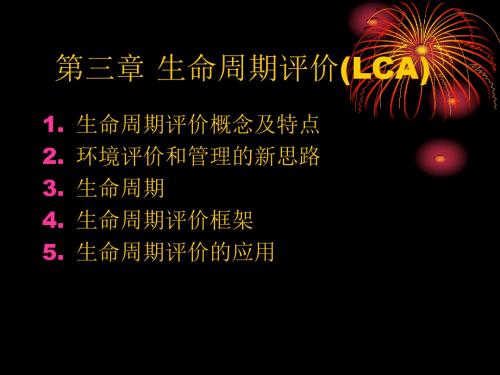
③ 生命周期是一种系统性、定量化的评价方法 ④ 生命周期评价是一种充分重视环境影响的评价方法 ⑤ 生命周期评价是一个种开放性的评价体系。
2、环境评价和管理的新思路
1)工业污染控制的四种模式演变 A 不顾环境的传统工业发展模式:资源—
产品—废物 B 污染末端控制模式: C 生产全过程控制模式——清洁生产 D 全生命周期控制模式
3 、生命周期
5个阶段 a. 生产前阶段 b. 产品生产 c. 产品运输 d. 产品使用 e. 翻新、再循环或最终处置
4 生命周期评价框架
生命周期评价的框架 1)研究目的与范围的
确定 2)清单分析 3)影响评价 4)结果解释
实际上,单纯的末端控制和生产过程控制,往往是 解决了局部的环境问题,而却给其它地方带来更 大的环境问题。
• 国际标准化组织( ISO) 定义:是一种评价与产品(包括产 品、服务或活动等)相关的环境负荷和潜在影响的技术。 它分三步完成:1)编制与研究系统相关的输入和输出数据 清单;2)量化评价那些输入和输出伴随的潜在环境影响; 3)联系研究的目标,解释清单分析和影响评价结果。
• LCA本质是检查、识别和评估一种材料、过程、产 品或系统在其整个生命周期中的环境影响。
2)研究范围
一般确定研究范围,要回答如下问题: • 为什么要开展这项研究 • 研究结果将如何运用 • 谁将使用这些研究结果 • 需要研究具体环境问题吗 • 研究需要具体到什么程度
(1)生命周期范围 (2)细节标准范围 (3)自然生态系统范围 (4)时空边界 (5)边界选择
2)清单分析
清单分析是对一种产品、工艺和活动在其 整个生命周期过程中的能量与原材料需要 量以及对环境的排放进行以数据为基础的 客观量化过程。其步骤包括。
生命周期评价方法及其应用

生命周期评价方法及其应用随着经济的发展和工业化程度的提高,人们对环境保护问题的认识逐渐加深。
在这样的背景下,生命周期评价方法逐渐受到人们的关注。
生命周期评价是对一个产品从矿产、制造、使用到废弃的整个过程进行评价,以确定产品对环境和资源的影响。
本文将介绍生命周期评价的基本概念、方法和应用。
一、生命周期评价的概念生命周期评价,又称为生命周期分析(LCA),是一种用于评估产品或服务对环境的影响的综合分析方法。
生命周期评价是从全生命周期的角度来考虑一个产品或服务的影响,包括原材料采集、制造、包装、运输、使用和废弃等环节。
这种方法可以帮助企业分析其生产活动的环境影响,指导企业加强环境保护,提高资源利用效率。
二、生命周期评价的方法生命周期评价的方法比较复杂,一般需要按照以下步骤进行:1.定义评价目标:明确评价的范围,包括评估方法的目的、评价对象、评价目标和评价指标等。
2.制定范围:确定评价对象的范围,包括所涉及的过程、产品或服务的生命周期阶段、所涉及的生产者和消费者,以及所需资源等。
3.收集数据:收集所需的数据,包括原材料、能源、废物或污染物排放等数据,并按照特定的参数进行分类。
4.建立评估模型:将收集的数据进行归纳、整合和处理,建立评估模型,并计算各项评价指标。
5.评价结果:对评价结果进行分析和解释,并提出改进建议。
三、生命周期评价的应用生命周期评价的应用非常广泛,可以用于评估各种产品和服务的环境影响。
下面介绍一些具体的应用:1.产品设计:生命周期评价可以帮助企业了解产品设计的全生命周期影响,以改善产品的环境性能。
2.政策制定:政府可以利用生命周期评价的结果来制定环境保护政策和标准。
3.市场溯源:生命周期评价可以帮助消费者了解所购买的产品的全生命周期影响,并选择对环境友好的产品。
4.企业管理:企业可以利用生命周期评价来识别环境风险,制定环保计划,加强环保管理。
四、生命周期评价的不足和面临的挑战尽管生命周期评价已经广泛应用,但它仍然存在一些问题。
产品生命周期评价

LCA清单分析:在长沙市内随机取13个点进行样品取样调查(样品重)。 • 主要对长沙市生活垃圾主要成分、运费计算、填埋气估算、渗滤液和影响评价 • 长沙市黑麋峰固体废弃物处理场的沼气收集后用于发电。假设发电厂7台机组24h 不断运转,所产生的沼气通过发电变成电能并入国家电网,每日能产生15万kWh, 解决4 万-5万人1d的用电需求
• (1)垃圾填埋场日处理量最高只有4000t,但2012年日处理量已达 4200t。针对生活垃圾量加速增长的情况,应对长沙市生活垃圾处理 方式进行改良,解决垃圾处理过于单一带来的影响。 • (2)长沙市生活垃圾卫生填埋处理后排放的主要污染物为CO2和CH4。 其中每吨垃圾排放的CO2在107kg左右,甲烷在51kg左右,对大气造 成的污染显而易见。填埋对温室效应的环境影响潜力为1.6*10-2kg当 量/(人*a),酸化的环境影响潜力为3.2*10-3当量/(人a)。长沙市 卫生填埋处理生活垃圾的环境影响潜力已经超过中国环境影响潜值标 准人当量基准值,因此应当重视其对环境造成的影响,寻求合理的方 法对城市生活垃圾加以管理和利用势在必行。 • (3)长沙市仅以填埋的方式处理生活垃圾,对垃圾资源造成了很大 的浪费,假设有机垃圾全部由甲烷菌进行无氧呼吸,每吨有机垃圾可 产生898kgCO2及548kgCH4。甲烷气体可以作为一种能源回收利用, 如利用甲烷发电,一方面给居民提供电力资源,另一方面解决了垃圾 填埋所产生污染气体的问题。
3、怎么进行生命周期评价
• 技术框架 LCA由4个相互关联的部分组成、即目标定义和范围界 定、清单分析、影响评价、结果解释。 • 近些年生命周期评价所用的方法大多采用席德立开发了一 套获取产品LCA清单数据的方法。
随着关于LCA的研究文献逐渐增多,我们可以更清晰地发现从LCA方法 论到LCA应用研究这一过渡特点。
第八讲 生命周期评价

第八讲生命周期评价Life Cycle Assessment1.生命周期产品生命周期的概念来自工业生态学中的生物代谢,亦即生物体在能量的推动下从环境中吸取营养物质,产出生物质,直至向环境中排出废料的全过程。
产品生命周期不仅是经济学术语,而且涉及环境、技术、经济、社会等多个领域的概念,指产品从自然中来到自然中去的全部过程,也有的称“生命循环”或“寿命周期”,均是指产品从“摇篮到坟墓”的整个生命周期各阶段的总和,包括了产品的从自然中获取最初资源,经过原料采集和处理、加工制作、运销、使用复用、再循环,直至产品最终处置和废弃等环节组成的生命链。
产品生命周期示意图取自自然不同产品的生命周期在时间和空间尺度上可以有很大的差别。
如一座建筑物,它的生命周期可能长达1-2百年,而某些包装材料只有数周或数月的寿命。
产品的生命周期可以局限于同一地区,也可以遍及世界五大洲,如在澳大利亚开采铁矿石,在亚洲冶炼成钢材,输入欧洲制成汽车,出口北美洲销售,汽车报废后进入汽车坟场,或作为废铁运向南美洲。
产品生命周期分为5个阶段:原材料加工;产品生产制作;包装运销;产品使用;再生处置。
相关环境问题归成5 类:原材料选择;能源消耗;固体废料;废液排放;废气排放。
2、生命周期评价的由来生命周期最早用于实际的例子可追溯到1969年美国研究人员对可口可乐公司的饮料包装容器开展的一项能耗研究,这项研究试图从最初的原材料开采到最后的废弃物处理进行全过程的追踪和定量分析,为后来的生命周期分析方法奠定了基础。
分析工作涉及玻璃、钢铁、铝、纸和塑料等40种材料。
70年代美国、欧洲和日本的一些公司开展了类似的比较性的研究,作为企业内部产品开发和管理的决策支持工具。
80年代环境管理关注的焦点逐步转向危险废物和固体废物的管理,进一步推动了这一领域研究工作的发展。
1990年由国际环境毒理学与化学学会首次召开了有关生命周期评价的国际研讨会,在这次会议上提出了“生命周期评价”的概念。
lca 过程概念

LCA(Life Cycle Assessment,生命周期评价)是一项评估产品或服务在其整个生命周期中,从原材料获取、生产、使用到最终处置的环境影响和资源消耗的重要环境管理工具。
这个过程可以分为以下几个主要步骤:
1. 目的和范围的确定:明确评估的目标和范围,这决定了LCA的研究范围以及需要考虑的环境影响和资源消耗的类型。
2. 清单分析:收集和整理产品或服务在生命周期各阶段(从原材料提取、生产、使用到最终处置)的投入和排放数据,例如原材料、能源、水以及产生的废弃物等。
3. 环境影响的评估:基于清单分析的数据,评估产品或服务在生命周期各阶段对环境的影响,包括大气、水体、土壤等环境介质中的污染排放以及能源消耗等。
4. 改善和优化:根据评估结果,确定减少环境影响和资源消耗的关键环节,提出改进措施或替代方案。
5. 结果解释和沟通:将评估结果以易于理解的方式向利益相关方进行解释和沟通,以便于他们了解产品或服务的环境影响并做出相应决策。
LCA 过程可以应用于企业、组织或政府机构,帮助其了解产品或服务的真实环境成本,为可持续生产和消费提供决策依据。
课件:生命周期评价
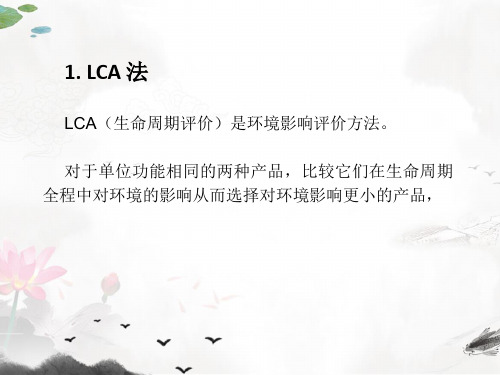
LCA(生命周期评价)是环境影响评价方法。
对于单位功能相同的两种产品,比较它们在生命周期 全程中对环境的影响从而选择对环境影响更小的产品,
4) LCA 实施顺序
1.设定目的与范围
明确开展LCA调查的目的与范围 LCA的方法即结果随设定的目的和范围而呈现多样性
2.清单分析
收集LCA研究对象产品和服务相关的资源、能源的投入和生产的产
生命周期评价的起源和发展
1990年由国际环境毒理学与化学学会(SETAC)首次主持召开了
有关生命周期评价的国际研讨会,在该次会议上首次提出了 “生命周期评价(Life cycle ssesment,LCA)”的概念。 1992年以后,以美国环境毒性和化学学会为主,SETAC组织西 方几个国家的有关科研机构成立了五个研究工作组,对LCA
开展了全面深人的研究工作,这五个小组的分工为:第一组 (英国)负责研究总体概念; 第二组(德国)负责研究LCA(生命周期清单)总概念; 第三组(日本)负责研究生命周期清单分析具体操作; 第四组(瑞典)负责研究环境影响分析; 第五组(法国)负责研究改善评价。 五个小组于1993年开始各自的研究,协调统一有关概念、定 义及具体操作处理方法等.使LCA有了长足的发展。
5.生命周期评价可以为授予“绿色”标签——产品的环 境标志提供量化依据
6.生命周期评价可以对市场行销进行引导,指导“绿色 营销”和“绿色消费”
生命周期评价的应用
固体废弃物管理
生命周期评价为固体废弃物管理提供了一种系统、 整体研究的观点,将城市固体废物管理系统的所有操作 活动(工艺过程)作为一个整体进行研究,包括从原材料 获取、产品制造、废物产生到废物收集、回收利用、焚 烧、堆肥、填埋等的过程。从而从理论上为废弃物管理 提供最佳的方法和途径。
第5章 生命周期评价

四、生命周ห้องสมุดไป่ตู้评价的应用
生命周期评价作为一种评价产品、 生命周期评价作为一种评价产品、工艺或活动的 整个生命周期环境后果的分析工具, 整个生命周期环境后果的分析工具,迄今为止在私 人企业和公共领域都有不少应用。 人企业和公共领域都有不少应用。 在私人企业, 在私人企业,生命周期评价主要用于产品的比较 和改进, 和改进,典型的案例有布质和易处理婴儿尿布的比 塑料杯和纸杯的比较, 较,塑料杯和纸杯的比较,汉堡包聚苯乙烯和纸质 包装盒的比较等。 包装盒的比较等。 在政府方面, 在政府方面,生命周期评价主要用于公共政策的 制定, 制定,其中最为普遍的适用于环境标志或生态标准 的确定, 的确定,许多国家和国际组织都要求将生命周期评 价作为制定标志标准的方法。 价作为制定标志标准的方法。
② 特征化:特征化主要是开发一种模型,这 特征化:特征化主要是开发一种模型, 种模型能将清单提供的数据和其他辅助数据 转译成描述影响的叙词。 转译成描述影响的叙词。目前国际上使用的 特征化模型主要有:负荷模型;当量模型; 特征化模型主要有:负荷模型;当量模型; 固有的化学特性模型;总体暴露—效应模型; 固有的化学特性模型;总体暴露—效应模型; 点源暴露—效应模型。 点源暴露—效应模型。 量化: ③ 量化:量化是确定不同环境影响类型的相 对贡献大小或权重, 对贡献大小或权重,以期得到总的环境影响 水平。 水平。
清洁生产、绿色产品、 清洁生产、绿色产品、生态标志的提出 和发展将会进一步推动生命周期评价的发展。 和发展将会进一步推动生命周期评价的发展。 目前, 目前,各国政策重点从末端治理转向控制污 染源、进行总量控制, 染源、进行总量控制,这在一定程度上反映 了现有法规制度无法单独承担对环境和公共 卫生造成的危机, 卫生造成的危机,从另一侧面也反映了生命 周期评价将成为未来制定环境问题长期政策 的基础。从某一角度看, 的基础。从某一角度看,生命周期评价反映 了现有环境管理已转向向各类污染源最小 排放最小化— 化—排放最小化—负面影响最小化的管理模 式,这对实现可持续发展战略具有深远的意 义。
- 1、下载文档前请自行甄别文档内容的完整性,平台不提供额外的编辑、内容补充、找答案等附加服务。
- 2、"仅部分预览"的文档,不可在线预览部分如存在完整性等问题,可反馈申请退款(可完整预览的文档不适用该条件!)。
- 3、如文档侵犯您的权益,请联系客服反馈,我们会尽快为您处理(人工客服工作时间:9:00-18:30)。
• inventory analysis
• life cycle impact • interpretation of results.
• 1.目的和范围的确定。 • 涉及到对研究目标、接受人群 和系统边界的确定,以满足潜 在应用的要求。根据研究目的 的不同,生命周期评价可分为 3类:概念的、初步的和全面 的产品生命周期评价。
混合生命周期评价模型 Hybrid Life Cycle Assessment Model
混合生命周期评价模型.
Hybrid Life Cycle Assessment Model 02
Tiered hybrid LCA 层次化混合生命周期评 价模型
重 点
01
Input-output–based hybrid LCA 基于投入—产出的混合 生命周期评价
• 主要对模型系统的潜在环境影响、 • It mainly assesses and analyzes the potential environmental 资源使用和能源消耗情况进行评 impacts, resource use and energy 估和分析,说明各阶段对环境、 consumption of the model system, 能源影响的相对重要性以及每个 and explains the relative 生产阶段或产品每个组成部分的 importance of the environmental and energy impacts at each stage 环境、能源影响量大小。 and the environmental and energy impacts of each component of each production stage or product.
03
Integrated hybrid LCA 集成化混合生命周期评 价
1.层次化混合生命周期评价模型( Tiered hybrid LCA)
• 该模型最早是由 Bullard等人在1978 年提出。对建筑产品而言,该模型 的主要思想是在建筑的材料运输、施工、运行及拆除阶段运用过程生 命周期评价模型。而对剩余的“上游”生命期阶段,如原材料挖掘和 施工机械制造阶段,采用投入—产出生命周期评价模型加以分析, 从 而揭示建筑产品的全生命期影响表现。 在运用该模型处理具体问题时 需要注意以下两个方面: 一是对两种模型在生命周期评价中结合点的 选择尤为重要, 即对哪些阶段采用投入—产出分析, 哪些阶段采用过 程分析; 二是在投入—产出分析和过程分析相结合时,要避免对同一 活动的重复计量。
• 2.清单分析(LCI)。
• 2.Inventory analysis • It involves the collection of related input and output data for each functional unit, which is mainly the material flow and energy flow within the product itself and between the product and the external natural environment system. This step involves the quantitative calculation of the inputs and outputs of the building he results obtained will be used for life cycle energy environmental impact assessment.
The energy consumption and environmental impact of the construction industry are huge. In order to deepen understanding of resource depletion and highlight the importance of environmental factors in national development, Life Cycle Assessment (LCA) was introduced into the construction industry to increase the sustainability of building products.
2018
建筑生命周期评价理论
BEGIN
目录 table of Contents
73 63
%
83
93
%
%
%
一、生命周期 评价的由来
二、生命周期 评价理论
三、生命周期 评价模型
四、生命周期的 建筑应用
一、生命周期评价的由来(The origin of life cycle assessment)
• 随着社会的进步和经济的发展, 人 们逐渐意识到资源和环境对于人类 生存的重要性, 可持续发展已成为 当今世界发展的重要主题。
• Features: Fully and systematically reflect the effects of a product's complete life process, not just at a single stage of product production.
01
SECTION TITLE
• 建筑业的能源消耗与环境影响巨大。 • • 为了深入对资源耗竭的了解, 突出 • 环境因素在国家发展中的重要性, 生命周期评价(LCA)被引入到建 筑业,以提高建筑产品的可持续性。
二、生命周期评价理论(Life cycle assessment theory)
• 定义:生命周期评价是一种对产品、 • 生产工艺及服务从“摇篮到坟墓” 生命期过程的环境负荷和资源消耗 进行评估的方法或工具。
Lorem ipsum dolor sit amet, consectetur
建筑生命周期全过程(The whole process of building life cycle) 对于建筑产品,其生命周期阶段包括原材料挖掘 与生产、运输、施工建造、运行和拆除5个阶段
三、生命周期评价理论
建筑生命周期评价主要包括四个阶 段 • 1.目的和范围的确定 • 2.清单分析 • 3.生命周期影响 • 4.结果释义 Construction life cycle assessment mainly includes four stages • determination of purpose and scope
2.基于投入—产出的混合生命周期评价
• ( Input-output–based hybrid LCA)模型根据产品具体的经济信息对投入产 出表中现有部门进行拆分或添加新的部门, 再将过程分析的数据应用到投 入—产出系统中。 Joshi对该模型的研究机理和应用给予了较为完整和详细的 论述。 他将该模型细分为6类。第一类是拟研究产品可被划分到现有投入产 出表中的某个部门 ; 第二类是在现有投入产出表中无法找到与拟研究产品相 对应的部门, 此时需根据产品的生产情况, 将其作为一个新的产业部门添加 到投入产出表中进行计算; 第三类是指现有产业部门口径过宽,需要对该部 门进行拆分,对拟研究产品单独加以考虑; 第四类是根据拟研究产品较为详 细的过程数据对多个产业部门进行拆分和添加的情况; 第五和第六类是在模 型中分别嵌入拟研究产品的使用和报废阶段的过程数据。
• 1.determination of purpose and scope.
• It involves the determination of research objectives, recipient populations and system boundaries to meet potential application requirements.Depending on the purpose of the study, life cycle assessment can be classified into three categories: conceptual, preliminary and comprehensive product life cycle assessment
周期
四、生命周期的建筑应用
Life cycle building applications
1.对建筑材料和部件的评价
• 在国外, Asif等通过研究8种建筑 材料后发现,对于住宅建筑、混 凝土的能耗量占建筑物化能总量 的61%,木材和瓷砖所占比例分 别为14%和15%。同时,混凝土 生产过程的 CO2排放量占建设期 CO2排放总量的99%。因此,减 少混凝土的使用对建筑节能减排 意义重大。 • 在中国学者中,帅小根等研究了 混凝土的资源消耗和环境影响表 现, 认为减少混凝土的使用是实 现建筑全生命周期资源节约的关 键。赵平等运用生命周期评价对 建筑材料的资源使用、 能源消耗 和环境影响进行了分析,认为从 建筑物化能角度来看, 砖混结构 建筑的资源使用量最大,钢结构 建筑的环境负荷最小。
周期
=三、生命周期评价模型
Life Cycle Assessment Model
基于过程的生命周期评价模型 Process-based Life Cycle Assessment Model
